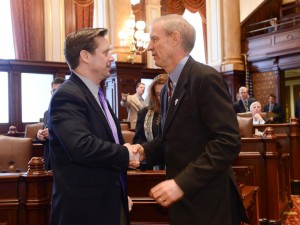State panel seeking government reduction
Gregory Harutunian — April 13, 2015
Illinois Gov. Bruce Rauner greets state Sen. Dan Duffy, R- Barrington Hills, on the senate floor in Springfield. Photo courtesy of Illinois.gov
State panel seeking government reduction. An executive order signed Feb. 17 by Illinois Republican Gov. Bruce Rauner has created the Local Government Consolidation and Unfunded Mandates Task Force, a 25-member group charged with identifying issues with local government and school district consolidations, and their inherent redundancy.
The panel’s membership includes state house and senate legislators from both sides of the aisle, former and current municipal elected officials, and education district members.
The action was taken based on the premise that state policy should encourage mutual cooperation between local governmental agencies and school districts to “consolidate and streamline functions” while eliminating unfunded mandates, according to the document. Illinois Republican Lt. Gov. Evelyn Sanguinetti was also tabbed to chair the panel.
The document outlines the sheer volume of 6,963 units of local government, 102 units of county governments, 905 school and community college districts, township governments numbering 1, 431, as well as 5, 525 special district and municipal governments as a major contributor to the state’s high property tax rolls.
It also indicated that the proliferation and funding of such entities can lead to the duplication of services, mandates left unfunded, and in some cases, over-funding. The task force is designed to “make recommendations that will ensure accountable and efficient government and education in the state.”
Asked about the panel’s grouping, Sanguinetti said in an email that “…the membership was selected for its wide range of viewpoints and diverse outlooks on the issue. I was requested to chair the task force, by Gov. Rauner, and its purpose is in keeping with his pledge to seek remedial measures for the state’s current situation.
“We have a timetable to conclude the research and present the results to him by Dec. 31, of this year, and we are looking to have an ongoing dialogue with the governor about our preliminary findings along the way.”
Sanguinetti also said that the panel has met several times since its inception to iron out procedural templates, and delegate specific areas of concern for investigation. There have been multiple presentations on the practicalities of consolidation, by membership and outside advisors, as the task force is an open forum.
Streamlining local governments will help them better provide core services to the hard-working families in Illinois,” Lt. Gov. Sanguinetti said. “I am honored to work for the taxpayers by helping their local governments become more efficient so they can better serve the people they represent.”
“Illinois has an excessive number of local government units and the state severely limits local governments’ ability to control their own costs,” Gov. Rauner said. “Consolidating local government and reducing the burden of unfunded mandates imposed by the state will reduce costs, increase efficiency and improve delivery of services.”



